
Art | Resources
Mountain Meadow Wool
 “100% American made and Wyoming grown, high-quality wool products and yarn, created with eco-friendly operations and fair prices for ranchers.” Purchase yarn and fiber for your own creations, blankets woven at the Faribault mill, and wool hoodies, hats, gloves, and mittens. All are variegated natural colors of the sheep wool.
“100% American made and Wyoming grown, high-quality wool products and yarn, created with eco-friendly operations and fair prices for ranchers.” Purchase yarn and fiber for your own creations, blankets woven at the Faribault mill, and wool hoodies, hats, gloves, and mittens. All are variegated natural colors of the sheep wool.
D’Artegnan
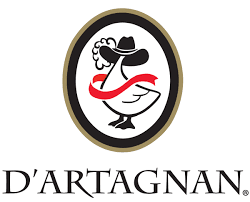 Many types of meat, poultry and game, all natural or organic. Also heritage breeds and wild.You’ll find everything here from chicken to wild boar. Plus charcuterie and sausage. “We believe food raised right tastes better. Before such buzz words existed, and for more than 30 years, D’Artagnan has been committed to free-range, natural production and sustainable, humane farming practices.”
Many types of meat, poultry and game, all natural or organic. Also heritage breeds and wild.You’ll find everything here from chicken to wild boar. Plus charcuterie and sausage. “We believe food raised right tastes better. Before such buzz words existed, and for more than 30 years, D’Artagnan has been committed to free-range, natural production and sustainable, humane farming practices.”
Want a Turkey Worth Gobbling? Here’s What to Look for on the Label
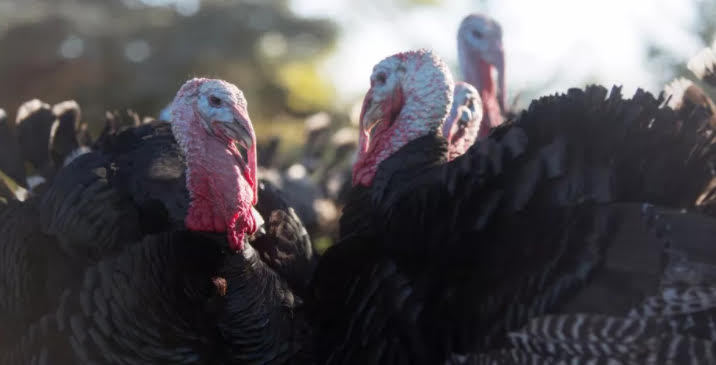
A couple of nights ago around the dinner table I asked my new family what everyone wanted for Thanksgiving dinner. Turkey, of course, homemade cranberry sauce, and gluten-free cornbread and rice stuffing with wild mushrooms topped the list. Since, as the best cook in the house, I’ll be doing most of the cooking, and we are living in Sonoma County, California—where we actually grow and raise some of the best food on Earth—I started wondering if we could get some kind of special turkey.
So I put together this list of what to look for on the label to help me find the perfect turkey for this year’s Thanksgiving dinner.
Here’s What You Get When You Buy a Cheap Turkey
The first thing to know about cheap turkeys is they are a hybrid breed that have been created to produce a lot of breast meat “Broad-breasted White” they are called. These turkeys are now so large that all are artificially inseminated because they simply can’t do it themselves.
They are also so big they cannot walk.
They are also bred to grow faster than the natural turkey and are give growth hormones.
These turkeys are raised in factory farms in overcrowded conditions.
Their feed is made from GMO corn and soy that has been sprayed with pesticides.
Excessive quantities of antibiotics are given to birds, and other chemicals may be used in processing.
PENN STATE EXTENSION: Modern Turkey Industry.
All Natural Turkeys
The word “natural” on the label of a turkey refers to how a turkey is processed, not raised.
A product can be claimed natural if it is minimally processed and contains no artificial ingredients, including chemical preservatives.
The United States Department of Agriculture (USDA) has a definition of “natural” that pertains to turkeys (and all meats)
According to the USDA, “all natural” meats and poultry can only be called such when:
- No animal by-products were fed to the animals
- No growth promotants were administered to the animals
- No antibiotics are used (except for ionophores used as coccidiostats for parasite control)
The USDA only approves phrases including “raised without antibiotics,” “no added antibiotics” or “no antibiotics ever,” which indicate the animal did not receive antibiotics in their feed, water or by injection. The phrase “antibiotic-free” is not approved for meat and poultry labels.
Natural turkeys are hybrid Broad-breasted Whites and the meat would still have pesticide residues from their feed, Most are fed a “vegetarian” feed made up of GMO corn and GMO soy. But “all natural” is a step in the right direction.
Your local natural food store will certainly carry an all-natural turkey and you might find them in some higher-end markets as well. They are slightly more expensive than the cheap turkeys and a good choice if you can’t afford organic.
Organic Turkeys
Once again, organic turkeys are hybrid Broad-breasted Whites. The difference with organic is they are raised with certified USDA organic practices, so the meat is free from hormones and other growth regulators, antibiotics, GMOs and pesticides. They are usually farm raised and often drink well water.
Most natural food stores sell organic turkeys. They are twice the price of natural turkeys.
Heritage Turkeys
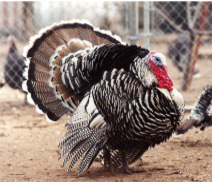 A heritage turkey is one of eight specific breeds certified by the American Poultry Association. These breeds were raised in the USA prior to the 1950s, when the poultry industry began to cross breeding the commodity Broad-breasted White turkeys that are commonly sold today.
A heritage turkey is one of eight specific breeds certified by the American Poultry Association. These breeds were raised in the USA prior to the 1950s, when the poultry industry began to cross breeding the commodity Broad-breasted White turkeys that are commonly sold today.
“Heritage” does not mean organic, all natural, or free range, though a true heritage bird should be free of artificial ingredients, raised on a farm and eat feed free from pesticides.
Heritage birds are different from Broad-breasted Whites in a number of ways. They:
- are smaller
- are prettier, often with elegant dark or colored feathers
- mature more slowly (24 to 30 weeks, versus about 12 to 18 weeks for a commodity turkey)
- can live longer—up to 15 years, instead of a year and a half.
- can have sex normally and reproduce
- have big, strong legs that can walk on their own
- are raised outdoors and freely roam on pasture
- eat the varied diet nature intended them to eat,
I’ve read that heritage birds are juicy and succulent and taste the way a turkey is supposed to taste. The meat is darker and gamier-tasting and tougher, so you won’t have the Broad-breasted White experience. And it can be harder to cook (here are some tips) . But you’ll actually be eating turkey, the same turkey everyone ate before 1950.
Heritage birds are more expensive to raise, and so are more expensive per pound to buy.
As of this writing there is no official certification program for the identification and labeling of heritage birds the way there is for organics. Although turkey producers are required to submit documentation to the USDA showing that the turkeys they’re going to call heritage are one of the officially recognized heritage breeds, this process is not as strict and regulated as needed to be dependably reliable.
Here’s where you really need to know your grower and ask questions and not rely on labels.
If you are willing to spend more money, do a little advance planning, and look beyond even your local natural food store, consider a heritage turkey. I’m considering this now because for once in my life I want to experiencing eating a REAL turkey.
Slow Food USA
American Livestock Breeds Conservancy
Livestock Conservancy
Wild Turkeys
When I used to live in a small village in a rural part of Northern California, we had wild turkeys and some of the locals would hunt and eat them. I never did but I’m very curious to know what they taste like.
You can purchase wild turkeys online that have been farm-raised on natural forage with supplemental feed.
Wild turkeys are small birds with a slightly gamey flavor
Now this would be more like the turkeys served at the first Thanksgiving.
The Turkey I Chose This Year
After all this research, I decided to pre-order a heritage turkey, grown by local Sonoma County 4H club members and sold through the Slow Food Russian River Heritage Turkey Project.
You can only get one if you come pick one up in Sonoma County, California. But look around your local community. There might be a similar program.
At $9.00 a pound, it will be the most expensive turkey I’ve ever purchased, but it will be well worth it. In addition to the enjoyment of flavor and satisfaction of curiosity, I will also be contributing to the education of future farmers and the preservation of heritage breeds, and I will experience food closer to it’s original state in nature. I think that’s an excellent investment.
I’m actually going to see if I can participate in the whole experience of visiting my turkey live and being at the slaughter instead of just picking it up in a bag.
I’ll let you know how this goes.
A Toxic Free Aesthetic
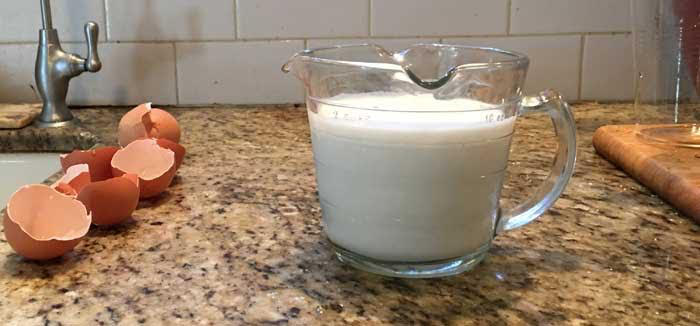
A few weeks ago I received this email from a reader:
“I’m wondering where you got your glass measuring cup shown here: https://www.debralynndadd.com/toxic-free-kitchen/dish/beverage/fresh-coconut-milk-and-cream/
It looks like it is free of painted-on markings and has multiple pour spouts. Just wondering what brand it is.”
I replied that I purchased it at Crate and Barrel a few years ago, but they don’t sell it any more.
But this question got me thinking about design and style and aesthetics, and how one might define a “toxic free aesthetic.”
Aesthetics in general have to do with the beauty of something.
An aesthetic is a set of principles underlying and guiding the work of a particular artist or artistic movement. So one might say “a Victorian aesthetic.”
But I think this term could just as well be used to refer to how design and it’s beauty or lack thereof results from a particular set of principles.
For example, the “modern” aesthetic is rooted in industrial manufacturing. So instead of items having a style that emerges from things made by hand from natural materials, for example, forms are simple and made from materials that can flow cheaply and easily through an industrial manufacturing process.
Which led me to wonder: If we started with being toxic free as a guiding principle, what might the aesthetic look like?
Measuring Cup
This measuring cup in the photo above I think is a good example of toxic free aesthetic.
It’s simple and direct, form following function.
It uses a nontoxic material.
And it incorporates the design into the material of the product, rather than use a different material.
In the case of the measuring cup, most measuring cups use paint to mark lines and numbers. While the paint is nontoxic by the time it reaches the user, the paint itself is toxic and likely would produce toxic waste during manufacture, use, and disposal.
So part of the aesthetic would be to choose materials throughout that create zero toxic exposure or waste at all stages of the life cycle.
 Clock
Clock
With the idea of toxic free aesthetic in mind, when I walked into a reception area and saw this cute little clock sitting on the counter, I immediately thought, “Oh this is toxic free aesthetic!”
Even though I hadn’t yet formulated guidelines, I could recognized it when I see it.
In real life, this appears to be an unfinished block of wood (no noticeable finish or odor) with a luminous LED display (the light aspect of it doesn’t really show in the photo).
I don’t know how they get the light into the wood, but the materials are simply wood and light.
I’m going to order one of these for myself. I need a clock I can see in the dark for my bedroom and this is perfect.
GEARONIC Wooden Alarm Clock. Tells time, date, temp and also has an alarm clock function via LED Light. Tells time, date, temperature and also has an alarm clock function. Three AAA batteries, “No buttons or plastic parts.”
NOTE: The one I saw was battery-powered. The description says it is powered with USB cable. I think you can use either.
Face
Two things inspired me to write this section.
First, I’ve been going to farmer’s markets every weekend for the past month and one of the things I’ve noticed is the beautiful faces of these farm women who are growing food and out in the fields. Just their beautiful bare faces without make-up.
And then I came across a photo ID card in my wallet with a picture that was taken on the spur of the moment. I had no makeup on because I don’t wear makeup everyday. I only wear makeup when I need to have a “professional” look.
And I looked at that bare-face ID card next to my driver’s license photo with makeup and I really preferred my bare-face photo!
 |
 |
| Debra with Make-Up | Debra without Make-Up |
I was surprised because the idea of “beauty” that is promoted in the consumer world is full makeup and hairstyle, but my aesthetic is becoming wanting to see the beauty of the actual face of the person, rather than have it obscured with makeup.
So I think the toxic free aesthetic is no makeup or minimal makeup rather than looking “painted,”
Creating a Toxic Free Aesthetic
I think this is an ongoing discussion. I would love to hear your thoughts.
And I would love to develop a toxic free aesthetic that designers could use to create products that we would enjoy using.
Feel free to post other products you think have a toxic free design aesthetic in the comments. With images.
Natural Fiber Winter Clothes for Plus Size Woman
When I was much younger and didn’t know anything about toxics, I was quite interested in fashion. I loved going shopping and trying on pretty clothes in nice stores. In those days there were nice dressing rooms and saleswomen who would get to know you and what you like and they would call you when something went on sale that they thought was right for you.
Nowadays shopping for clothes is quite different.
Back in 1978, when I first started writing about natural alternatives to toxic products, practically all clothing was polyester. Just about the only natural fiber clothing was jeans and t-shirts and flannel shirts.
And then as natural fibers became more popular, I could go into stores like Macy’s and Nordstrom’s and there would be racks of pretty dresses and shirts and jackets and sweaters made from natural fibers. I even still have linen shirts that I bought at TJMaxx.
But I’m sad to report that it seems like the tide has turned again. Two weeks ago I went shopping here in California and virtually all women’s clothing is now made of synthetic materials. I couldn’t even find a pair of jeans (for women) that didn’t have spandex in them and there were no conduroy pants at all.
Having just spent 15 winters in Florida, I had no winter clothing at all.
I didn’t need anything fancy. I’ve been dressing “plain” for years, inspired by the Amish and their beautiful quilts made from blocks of solid-color fabrics—scraps from the making of their simple solid-color clothing. In Florida this translated into solid color cotton capri pants and solid-color cotton tank tops. I had two drawers: one with tops and one with pants. Every morning I would just open the drawer and take out one of each and I was done dressing. I also had some big linen shirts in solid colors.
What I was looking for, for my California version of dressing plain, was simple long-sleeve cotton t-shirts and solid-color corduroy pants. So I went to a website that I have occasionally purchased from in the past called Woman Within, and I found exactly what a wanted.
Here’s what I purchased:
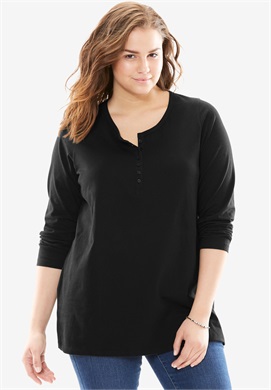 |
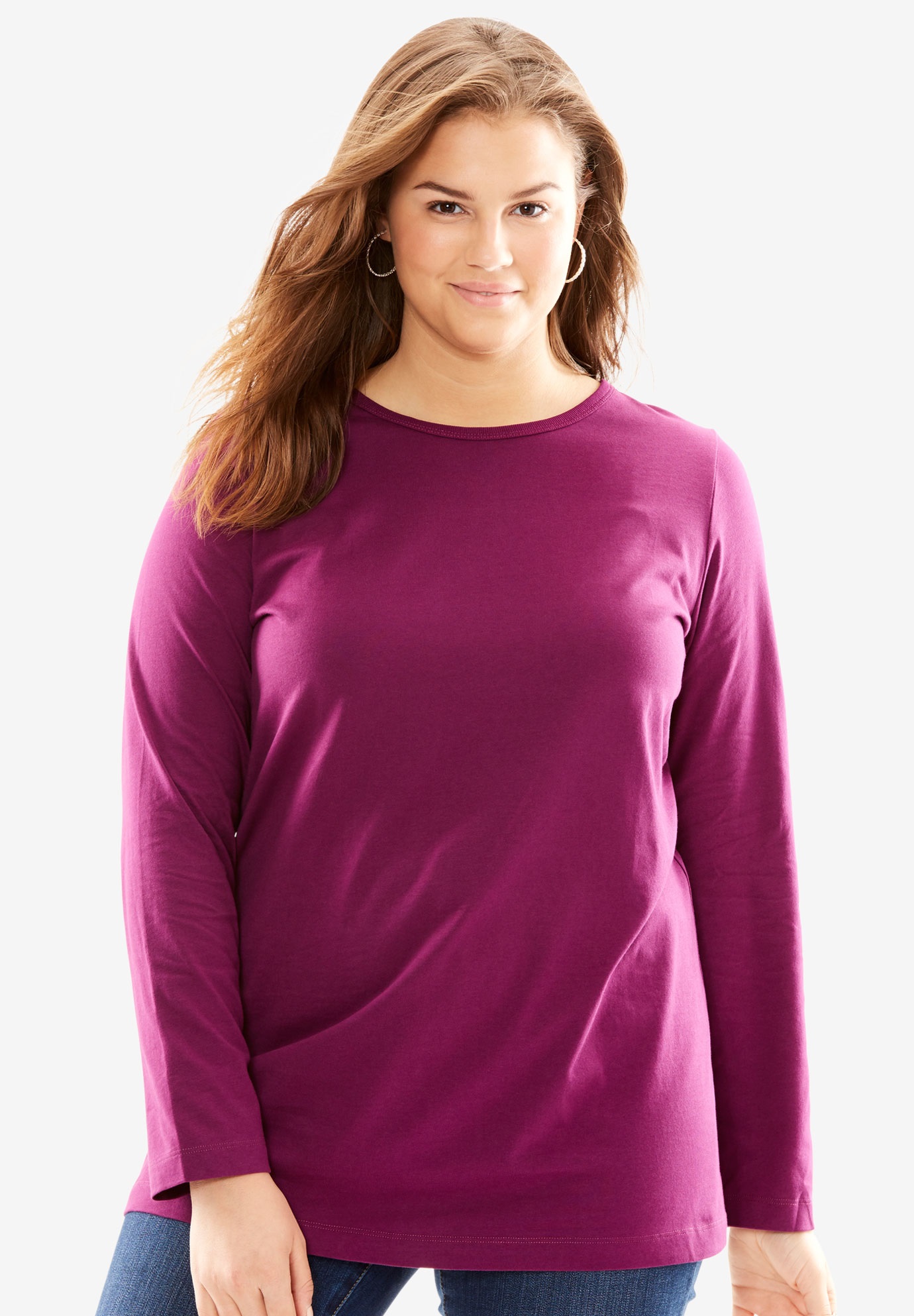 |
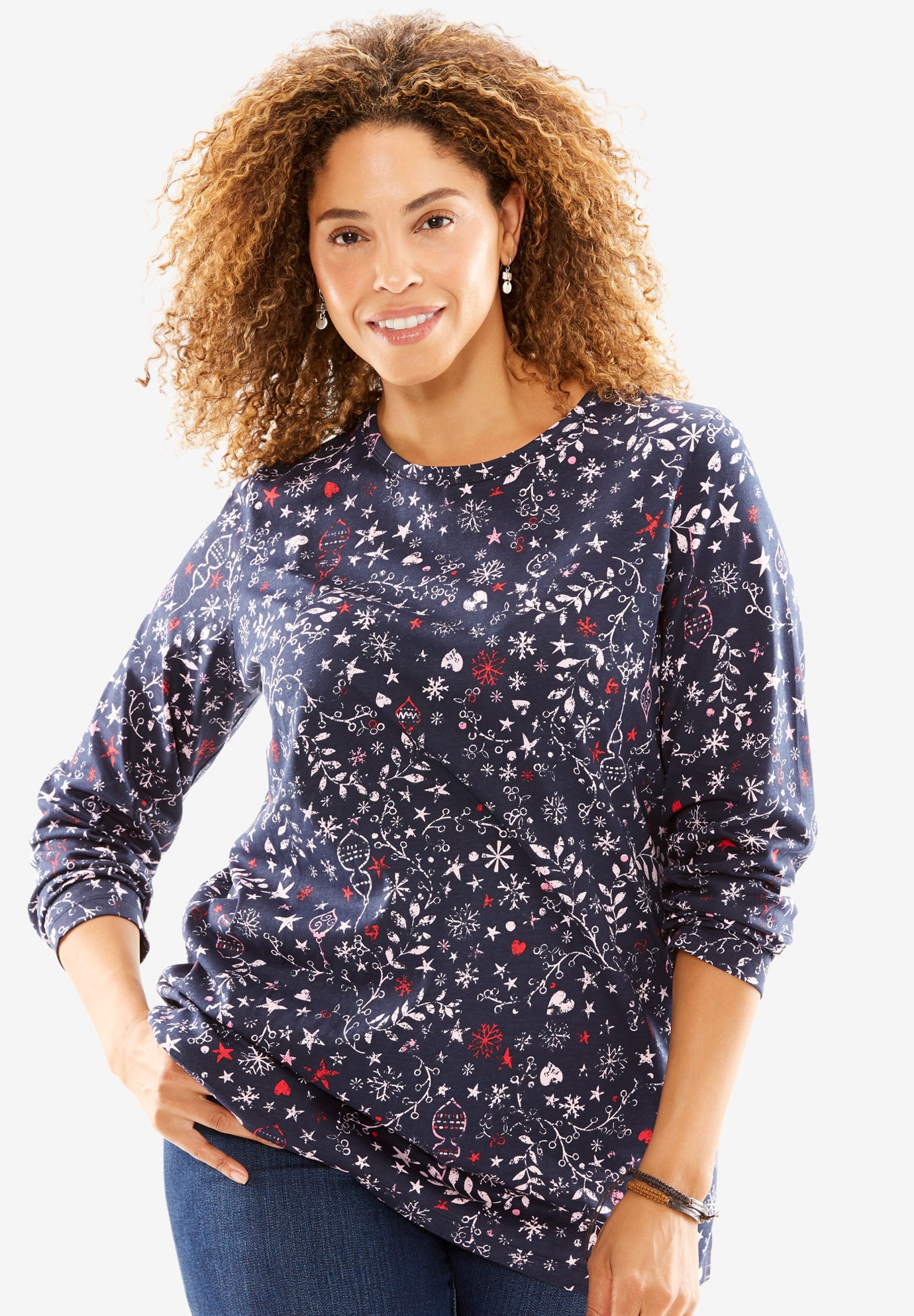 |
| T-shirt, Perfect, with long sleeves, Henley neck | Crew Neck Perfect T-Shirt | T-shirt, Perfect, with long sleeves, crewneck |
| soft, washable combed cotton knit, imported | washable soft pure cotton, imported | soft, washable combed cotton knit, imported |
| NOTE: The description says “long sleeve” but they were I little shortchanged for my arms. However, I love this shirt so much it doesn’t matter.. | NOTE: This neckline has a feminine cut with more space than a standard crew neck. | NOTE: This color is called “Navy Holiday”. Haven’t received these yet to comment. |
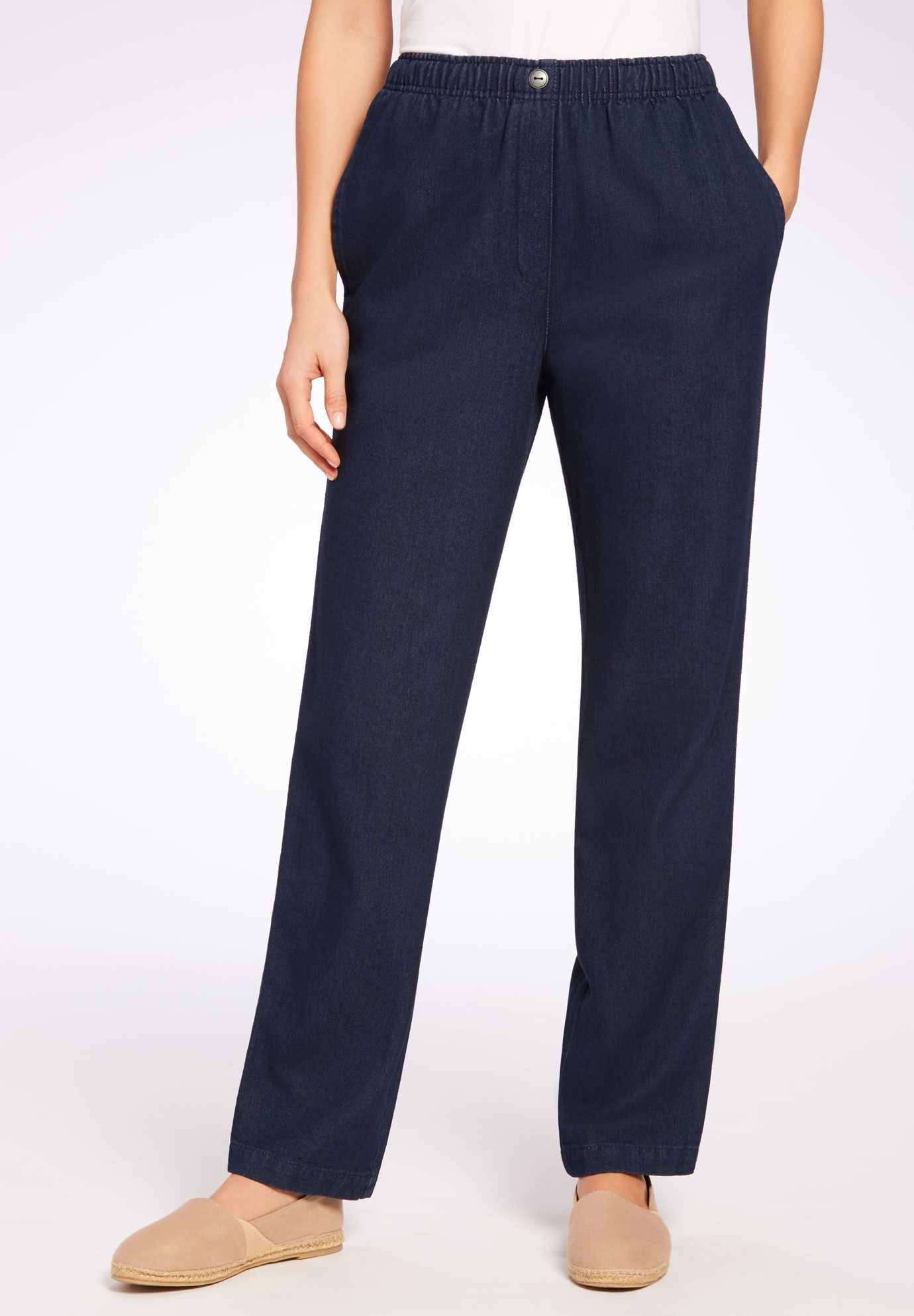 |
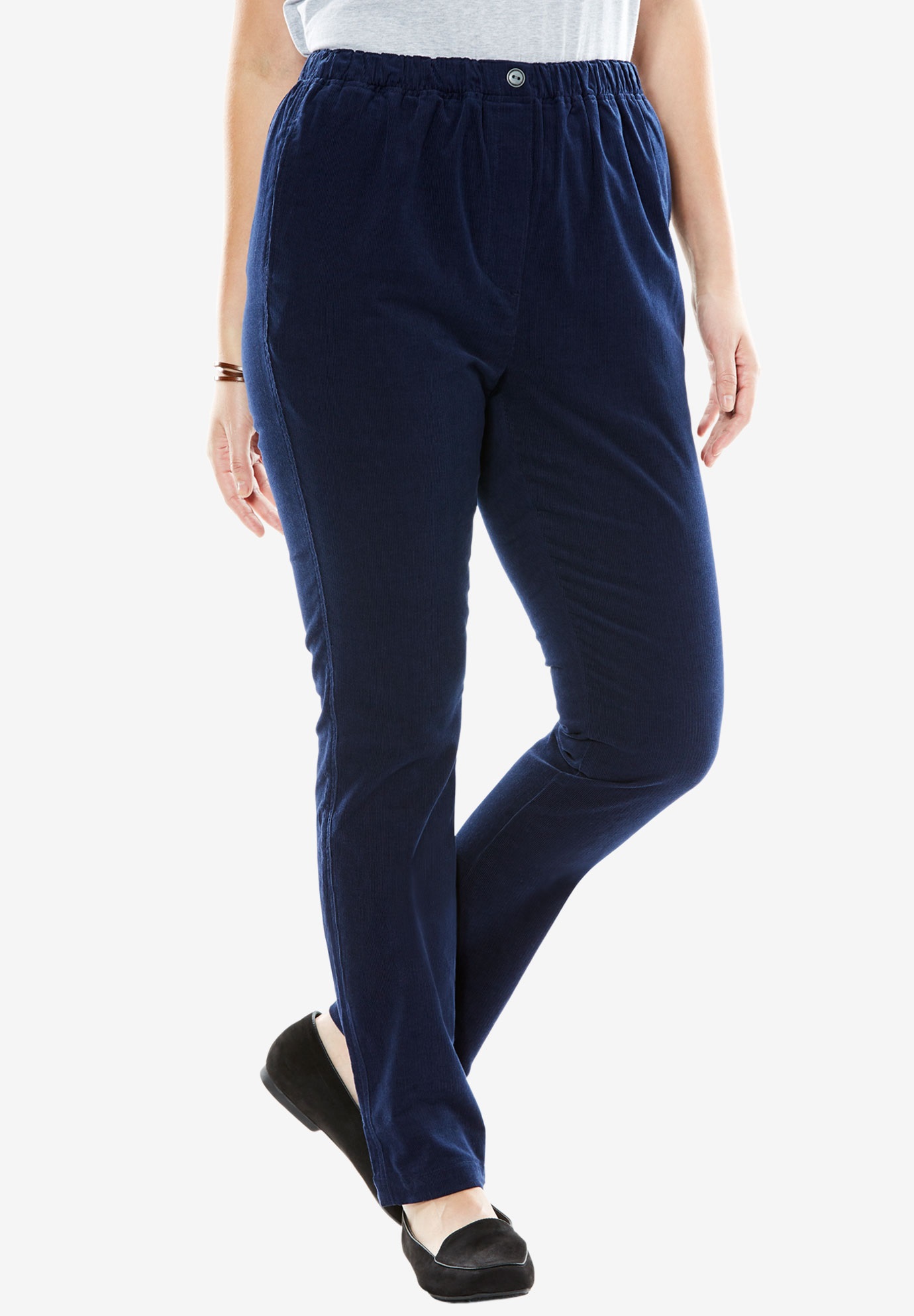 |
|
| Pants in corduroy with comfortable waist | 100% Cotton Comfort Pull On Jean | |
| soft woven washable cotton corduroy | washable woven cotton | |
| NOTE: These are actually cut big. Next time I’ll order one size smaller. | NOTE: Haven’t received these yet to comment. |
Badger Certified Organic Body Care
 USDA certified organic body care products, certified to food grade standards. Badger has been around since 1995. You may know their first product “Badger Balm,” which was created by a carptenter to heal his cracked hands. You’ve seen this brand on the shelves of many stores. But did you know that it’s a small, family-owned, family-run company in New Hampshire? “We blend the finest organic plant extracts, exotic oils, beeswax, and minerals to make the safest, most effective products possible to soothe, heal, protect and otherwise treat your body. We work hard, have fun, and incorporate honesty, respect, and integrity into everything we do…We only use ingredients that fit our rigorous natural standards for healthy agriculture, minimal processing, sustainable supply chain, and health giving properties. For example, the organic extra virgin olive oil we use in most of our products comes from a single family estate in southern Spain and it is the best olive oil we’ve ever tasted. And, the organic rose essential oil we use in all of our rose products is steam distilled in Bulgaria from rose petals picked the very same day. It takes 5 tons of rose petals to make one liter of this precious essential oil. We combine years of tradition and research with beautiful artwork and lots of love to create products naturally rich in powerful antioxidants and vitamins for healthier people and a healthier planet.” Links to Ingredients and Growers and Philosophy of Formulation. “We believe that true organic agriculture goes beyond the elimination of synthetic chemicals to a harmonization and sustainability of farmers, producers, consumers, and the land that we all share. Our goal at Badger is to take the organic certification as a first step on a road toward cultivating a higher standard for ingredients from the farm to the factory. We are working towards sourcing ingredients that are grown biodynamically, traded fairly, processed with thoughtful intention and to create products for all those in need of organic healing body care that works.”
USDA certified organic body care products, certified to food grade standards. Badger has been around since 1995. You may know their first product “Badger Balm,” which was created by a carptenter to heal his cracked hands. You’ve seen this brand on the shelves of many stores. But did you know that it’s a small, family-owned, family-run company in New Hampshire? “We blend the finest organic plant extracts, exotic oils, beeswax, and minerals to make the safest, most effective products possible to soothe, heal, protect and otherwise treat your body. We work hard, have fun, and incorporate honesty, respect, and integrity into everything we do…We only use ingredients that fit our rigorous natural standards for healthy agriculture, minimal processing, sustainable supply chain, and health giving properties. For example, the organic extra virgin olive oil we use in most of our products comes from a single family estate in southern Spain and it is the best olive oil we’ve ever tasted. And, the organic rose essential oil we use in all of our rose products is steam distilled in Bulgaria from rose petals picked the very same day. It takes 5 tons of rose petals to make one liter of this precious essential oil. We combine years of tradition and research with beautiful artwork and lots of love to create products naturally rich in powerful antioxidants and vitamins for healthier people and a healthier planet.” Links to Ingredients and Growers and Philosophy of Formulation. “We believe that true organic agriculture goes beyond the elimination of synthetic chemicals to a harmonization and sustainability of farmers, producers, consumers, and the land that we all share. Our goal at Badger is to take the organic certification as a first step on a road toward cultivating a higher standard for ingredients from the farm to the factory. We are working towards sourcing ingredients that are grown biodynamically, traded fairly, processed with thoughtful intention and to create products for all those in need of organic healing body care that works.”
Bill Gates and Steve Jobs raised their kids tech free

Interviews with Bill Gates, Steve Jobs, and other tech elites consistently reveal that Silicon Valley parents are strict about technology use.
I think it’s important in today’s world for kids to become familiar with technology and know how to use it, but not have their entire world be on-screen.
I have an iMac and a MacBook and an ipad and an iphone and I know that seems like a lot, but I use them to do my work and keep in communication with my readers and other businesses. But they are not my whole life. I also have direct conversations with people face-to-face, spend time in nature, and have a reality of the real world that is not filtered through someone else’s online presentation. I used to have a friend who would say she wanted me to come visit so we could eat chocolate cake together, and you can’t eat chocolate cake via email.
I remember life before technology and I wonder if today’s generation even know what that’s like.
We are human beings whose lives are supported by our relationships with other humans and the natural environment. Technology is second in importance to the fundamentals of life in my world,
INDEPENDENT: Bill Gates and Steve Jobs raised their kids tech free and it should’ve been red flag
Alderspring Ranch Grass-Fed Beef
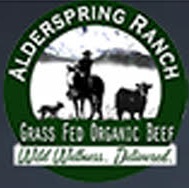 “100% grass fed and finished, certified organic beef grown on a family ranch in the wild and remote mountains of Idaho for over 23 years…We’ve been raising grassfed beef for over 20 years, and certified all of our operation as organic nearly a decade ago. We are one of the few organic grassfed beef producers in the country, carrying the dual labeling of “grassfed” as well as “certified organic.” We’ve taken our beef past the labels into an area we call “wild” that reflects the pristine wild country we grow our beef in, and growing practices that mimic nature as much as possible. We have a passion for caring for our land and livestock. We are also passionate about growing good food.”
“100% grass fed and finished, certified organic beef grown on a family ranch in the wild and remote mountains of Idaho for over 23 years…We’ve been raising grassfed beef for over 20 years, and certified all of our operation as organic nearly a decade ago. We are one of the few organic grassfed beef producers in the country, carrying the dual labeling of “grassfed” as well as “certified organic.” We’ve taken our beef past the labels into an area we call “wild” that reflects the pristine wild country we grow our beef in, and growing practices that mimic nature as much as possible. We have a passion for caring for our land and livestock. We are also passionate about growing good food.”
Costco Tackles Toxics With A New Policy
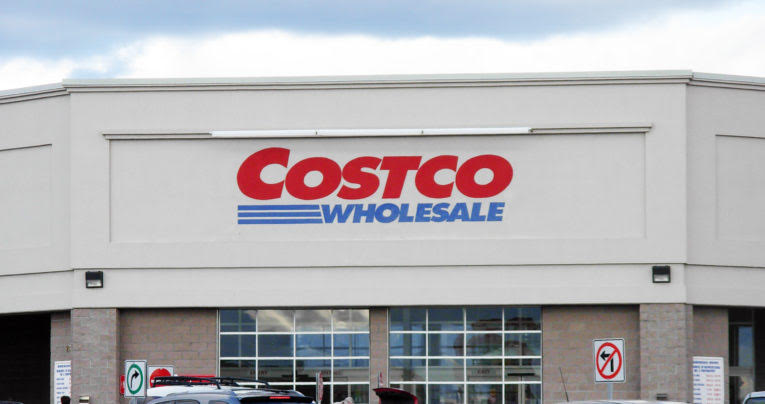
Costco has announced a new policy that will reduce harmful chemicals in the products they sell.
As a Costco member UI’ve been seeing a trend in this direction at their stores. I’m happy to see they will be continuing in this direction.
SAFER CHEMICALS, HEALTHY FAMILIES: Costco develops new safer chemicals policy
Phone Soap
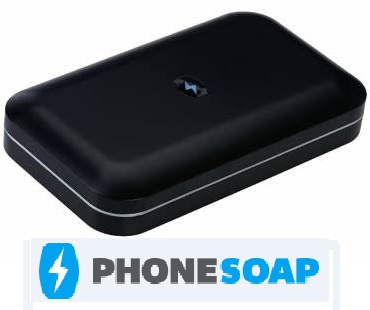 ABC News reported, “When people in New York City were asked which they thought was dirtier — the sole of your shoe, a toilet seat or a cell phone — the answer was overwhelmingly the toilet seats. But they were wrong — your cell phone is more filthy.” Phone Soap uses ultraviolet light to safely sanitize your cellphone. Also accessories such as a microcord so you can charge your phone while it is being sanitized and and an antimicrobial phone case that protects your phone from germs.
ABC News reported, “When people in New York City were asked which they thought was dirtier — the sole of your shoe, a toilet seat or a cell phone — the answer was overwhelmingly the toilet seats. But they were wrong — your cell phone is more filthy.” Phone Soap uses ultraviolet light to safely sanitize your cellphone. Also accessories such as a microcord so you can charge your phone while it is being sanitized and and an antimicrobial phone case that protects your phone from germs.






